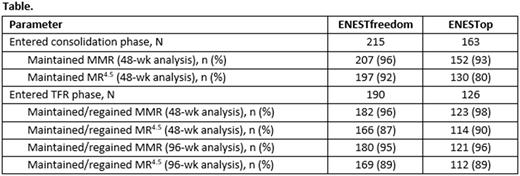Abstract
Background: The ability to stop TKI therapy without loss of response (ie, TFR) is a new treatment goal for patients (pts) with CML-CP. Reasons for considering TFR include relief from TKI-related adverse effects, family planning, and decreased financial burden. ENESTfreedom and ENESTop have shown durable TFR rates through 96 wk after stopping frontline and second-line nilotinib (NIL), respectively. This analysis evaluated the impact of treatment cessation on overall disease outcomes in these studies.
Methods: Pts with CML-CP who received ≥ 2 y NIL (ENESTfreedom) or ≥ 3 y total TKI (ENESTop; > 4 wk imatinib, then ≥ 2 y NIL) and achieved MR4.5 (BCR-ABL1IS ≤ 0.0032%) on NIL entered a 1-y NIL consolidation phase. Pts who met protocol-defined criteria for sustained deep molecular response (MR) were eligible to enter TFR. NIL was reinitiated in pts with loss of major MR (MMR; BCR-ABL1IS ≤ 0.1%) in both studies and also in pts with confirmed loss of MR4 (BCR-ABL1IS ≤ 0.01%) in ENESTop. This analysis compared disease outcomes in pts who stopped NIL and attempted TFR (first 48 wk) vs pts on NIL for the same duration (48-wk consolidation). Disease outcomes included ability to maintain MR (or regain MR upon retreatment), progression to accelerated phase/blast crisis (AP/BC), AEs, and CML-related deaths.
Results: In ENESTfreedom and ENESTop, TFR rates at 48 wk (primary endpoint) were 51.6% (98/190) and 57.9% (73/126), respectively. In ENESTfreedom, among all pts who entered TFR, the proportion who maintained MR at 48 wk or regained MR by the 48-wk cutoff was 96% for MMR and 87% for MR4.5, vs 96% and 92% who maintained these responses during the 48-wk consolidation (Table). All 86 pts who reinitiated NIL regained MMR; 1 pt later lost MMR with continued treatment (F359V mutation). No pt progressed to AP/BC or died due to CML. Similarly, in ENESTop 98% and 90% of pts maintained/regained MMR and MR4.5, respectively, during TFR vs 93% and 80% who maintained these responses during consolidation (Table). Of 51 pts who reinitiated NIL (loss of MMR, 34; confirmed loss of MR4, 17), 48 regained MR4 and 47 regained MR4.5. Of 34 pts who reinitiated NIL due to loss of MMR, 33 regained MMR; 1 pt discontinued from the study without regaining MMR after 20 wk of retreatment (no mutation; BCR-ABL1IS at study exit = 9.8%). No pt progressed to AP/BC or died due to CML. Data from 96-wk analyses in both studies were consistent with those at 48 wk (Table).
In both studies, overall AE rates (any grade) were generally comparable or lower during TFR vs on treatment and decreased over time in TFR (96-wk analyses). Among 100 pts in ENESTfreedom who remained in TFR for > 48 wk, AE rates were 85%, 76%, and 62% during consolidation and the first and second 48 wk of TFR, respectively. In ENESTop (n = 73), AE rates were 79%, 82%, and 63% during consolidation and the first and second 48 wk of TFR, respectively. Unlike other AEs, musculoskeletal pain (MSP) AEs increased during the first 48 wk of TFR (ENESTfreedom, 34%; ENESTop, 48%) vs consolidation (ENESTfreedom, 17%; ENESTop, 14%), but then decreased during the second 48 wk of TFR to rates seen during consolidation (ENESTfreedom, 9%; ENESTop, 15%). Few MSP AEs during TFR (first and second 48 wk, respectively) were grade 3/4 (ENESTfreedom, 2% and 0%; ENESTop, 3% and 1%); none were reported as serious AEs. Most MSP AEs during TFR were transient and readily managed with non-steroidal anti-inflammatory drugs (NSAIDS); no pt restarted NIL as a result of MSP AEs.
In ENESTfreedom, 1 pt became pregnant twice during TFR, delivered full-term healthy babies on both occasions, and has remained in the TFR phase in MR4.5 throughout. In ENESTop, 1 pt became pregnant at 60 wk during TFR, discontinued from the study due to pregnancy, and delivered a full-term healthy baby (pt maintained MR4 throughout TFR).
Conclusion: In both studies, pts who attempted TFR had similar disease outcomes to those on NIL during consolidation. Overall AE rates were generally comparable or lower during TFR vs consolidation except for transient MSP events, which tended to emerge early after treatment cessation and were readily managed with NSAIDS. TFR can allow for pregnancy in women with CML-CP of childbearing potential, but requires careful consideration of the potential risk of treatment reinitiation during gestation/lactation. These findings suggest that treatment cessation in the context of TFR offers pts valuable time off treatment without affecting overall disease outcomes.
Saglio: Ariad: Consultancy, Honoraria; Incyte: Consultancy, Honoraria; BMS: Consultancy, Honoraria; Pfizer: Consultancy, Honoraria; Roche: Consultancy, Honoraria; Novartis: Consultancy, Honoraria. Hughes: Ariad: Honoraria, Membership on an entity's Board of Directors or advisory committees, Research Funding; Bristol-Myers Squibb: Honoraria, Membership on an entity's Board of Directors or advisory committees, Research Funding; Novartis: Honoraria, Membership on an entity's Board of Directors or advisory committees, Research Funding. Hochhaus: ARIAD: Research Funding; Novartis: Research Funding; BMS: Research Funding; Pfizer: Research Funding; Incyte: Research Funding; MSD: Research Funding. Giles: Novartis: Consultancy, Research Funding. Radich: Novartis: Consultancy, Other: lab contracts for bid and service assays; Ariad: Consultancy; Amgen: Consultancy; Gilliad: Consultancy; BMS: Consultancy; Pfizer: Consultancy. Gopalakrishna: Novartis: Employment, Equity Ownership. Deng: Novartis Pharmaceuticals Corporation: Employment. Fellague-Chebra: Novartis: Employment. Acharya: Novartis: Employment. Mahon: Pfizer: Speakers Bureau; BMS: Consultancy, Speakers Bureau; Novartis: Research Funding, Speakers Bureau; Incyte: Consultancy, Speakers Bureau.
Author notes
Asterisk with author names denotes non-ASH members.


This feature is available to Subscribers Only
Sign In or Create an Account Close Modal